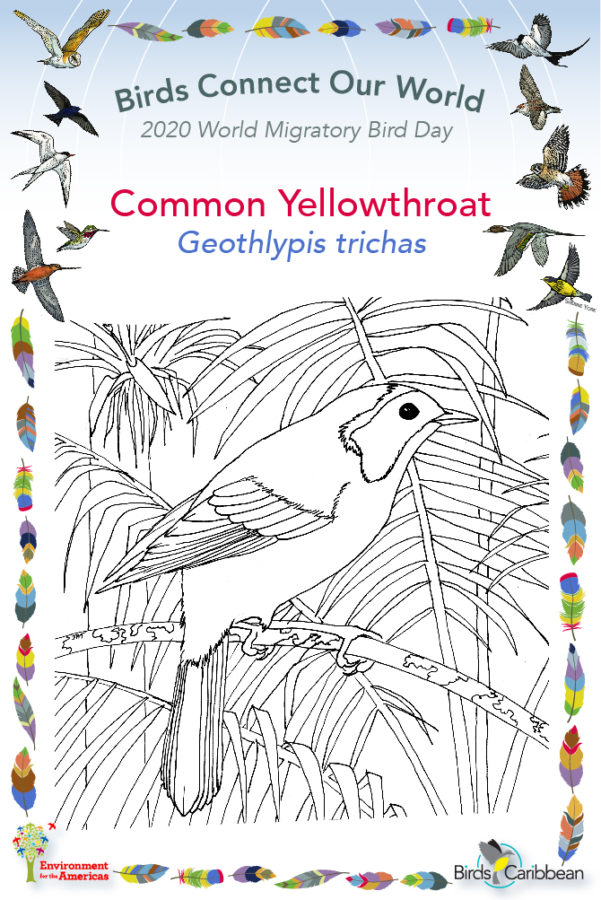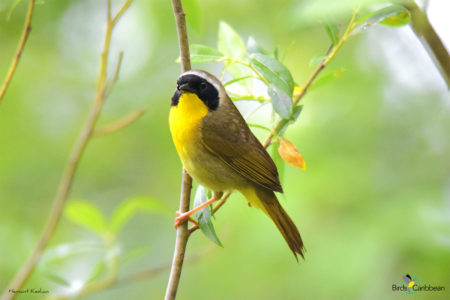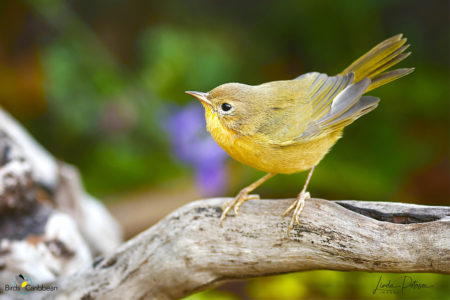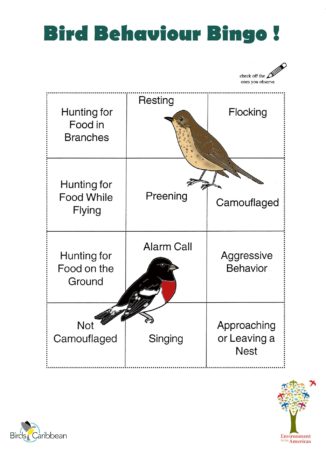Celebrate World Migratory Bird Day (WMBD) with us in our virtual “Birds Connect Our World” edition! Have fun learning about a new migratory bird every day. We have colouring pages, puzzles, activities, and more. Download for free and enjoy nature with your family at home.

Migratory Bird of the Day: Common Yellowthroat

Common Yellowthroats are small active warblers, olive colored above with a bright yellow throat and upper breast. Males have a striking black ‘bandit’ mask, edged above with whitish gray. Females are plainer but show a contrast between a yellow throat and olive-brown face.
This warbler tends to skulk and hide in thick vegetation, often staying near to the ground. In fact, ‘Geothlypis’ the name of the genus (group of birds) this warbler is in, means ‘earth finch.’ It’s ground-dwelling foraging habits also give this bird its local name ‘Reinita Pica Tierra’ in Puerto Rico. Although often out of sight, you can find this warbler by listening for its call—a distinctive loud tchuck.
Common Yellowthroats breed across a huge area of the US and Canada. After breeding their behaviour varies, some birds stay put while others migrate. Some make long journeys, travelling from Canada to Central America. Others spend the winter in the Caribbean. They are most common in the Bahamas, Greater Antilles and Cayman Islands. In the Bahamas take care not to confuse Common Yellowthroats with the Bahama Yellowthroat! This endemic bird looks very similar but is larger, slow moving, has a longer heavier looking bill, and more uniformly yellow underparts.
During the winter you can find Common Yellowthroats in a variety of habitats, including pine, dry and montane forests, pastures, shade coffee, mangroves, and bushy areas often close to wetlands. They eat insects, which they often search for on the ground. Their diet includes flies, beetles, ants, termites, bees, wasps, grasshoppers, dragonflies, damselflies, moths, butterflies, and caterpillars! Like many warblers Common Yellowthroats migrate at night, making them vulnerable to collisions with buildings and other man-made structures. Learn more about this species, including its range, photos, and calls here.
Colour in the Common Yellowthroat!
Download the page from Migratory Birds of the West Indies Colouring Book. Use the photos below as your guide, or you can look up pictures of the bird online or in a bird field guide if you have one. Share your coloured-in page with us by posting it online and tagging us @BirdsCaribbean #WMBD2020Carib
Listen to the calls of the Common Yellowthroat
The calls of the Common Yellowthroat are a strong “chuck” sound.
Puzzle of the Day
Click on the images below to do the puzzles. You can make the puzzle as easy or as hard as you like – for example, 6, 8, or 12 pieces for young children, all the way up to 1,024 pieces for those that are up for a challenge!


Activity of the Day
FOR KIDS: Watching a birds behaviour can be a really great way to helping to identify which species you are seeing. Especially with tricky birds like warblers that can look similar to each other. Practice your bird behaviour watching skills with our bird behaviour bingo game. Spend some time watching birds and tick off behaviours as you spot them.
FOR KIDS AND ADULTS:
- Take a walk and see if you can spot any migratory warblers. Use a bird field guide or the FREE Merlin bird ID app to help you identify the birds you are seeing.
- Enjoy the videos below of Common Yellowthroats in the wild! The first shows a male in breeding pluming, singing his characteristic “whichity-whichity-whichity” song; in the Caribbean you might hear this in spring before males migrate northwards. The second video shows a female Common Yellowthroat perched, you can see the difference in plumage between her and the male. Finally there is a Common Yellowthroat in winter plumage feeding on the ground, where this species can often be found!
- Visit MigratoryBirdDay.org for many more free activities and resources to learn about migratory birds, their threats and conservation actions you can take.

